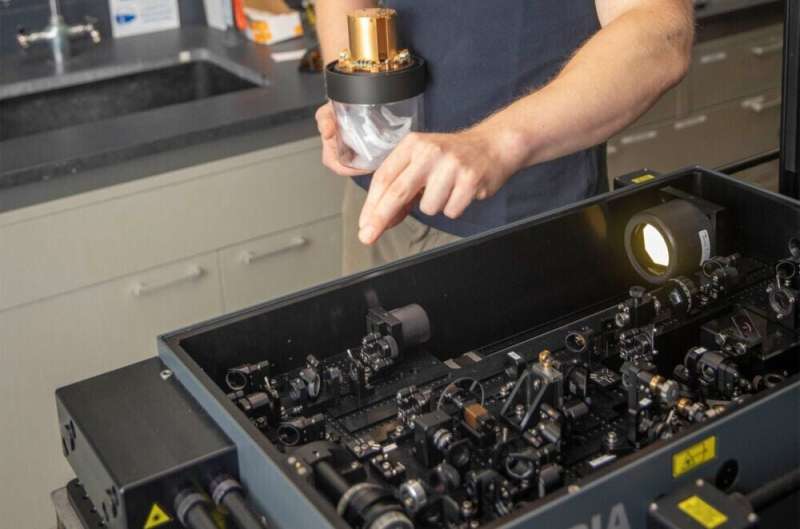This article has been reviewed according to Science X's editorial process and policies. Editors have highlighted the following attributes while ensuring the content's credibility:
fact-checked
peer-reviewed publication
trusted source
proofread
Researchers use light to make spins more efficient, easier to manipulate

Electronic devices run on the fundamental property that electrons' charge helps them to move and generate current. Now imagine another property—this one in the quantum realm—that can help electrons behave more energy-efficiently. Spintronics makes use of the spin of an electron, a fundamental property dependent on its intrinsic angular momentum.
"People want to talk to spins as the information bit for quite a while now, as the quantum-mechanical property of a spin doesn't cost as much energy to switch on or to sustain as electrical current. But it is harder than it looks," said Sascha Feldmann, research group leader at the Rowland Institute. "You usually have to apply strong magnetic fields to talk to the tiny magnetic moment a spin has."
An electron can have two spin states—up or down—and these can be used to store and process information. But manipulating them can be tricky, requiring the use of magnetic fields on very perfectly ordered materials at extremely low temperatures to work.
Feldmann and his team of researchers, both here and at the University of Cambridge, were able to generate electron spin domains with none of these factors at hand. They simply shined circularly-polarized light at room temperature on halide perovskite films, a very easy-to-make, but highly disordered semiconducting material. Lo and behold, within a few picoseconds (trillionths of a second), the electrons developed different spin states and formed local spin domains. The results were published in a paper in Nature Materials.
"With light we can now optically address spins, which so far one could only learn about using magnetic measurements," said Feldmann, a corresponding author of the paper. "With just the polarization of our light, we are able to talk to the spins of the electrons, non-invasively."
To study this, the researchers developed a special microscopy technique based on the information encoded in the spiraling handedness of the light. Left or right-handed circularly-polarized light was used to generate the spin-up or spin-down state, and using that information, they were able to see the spins of the material in detail.
At this scale in each domain, spins survived for much longer than expected. Because they were using microscopy, they were also able to see spin transport. "Like how charges flow in a wire, we can see how the spins move," said Feldmann.
The researchers observed a phenomenon called spin-momentum locking. This means, for an electron, the spin state determines the direction of its movement. Being able to not only observe, but also manipulate the movement of the spins opens possibilities for the clever design of materials with electron spins to be optically manipulated.
Once a material is magnetized, even optically, it remains that way and does not need external power to maintain its state. This allows spintronics to be very useful, a common use being the more stable and efficient storage of data in computer storage systems. It also has uses in quantum computing, as the quantum property of spins opens new ways of easily performing certain computing tasks, tasks that would take a traditional computer thousands of years to complete.
"A semiconductor is what interacts with light and a ferromagnet is what is magnetic and does stuff with spins. Here we have found something that combines the best of both worlds. It is amazing, because it brings the spintronics people to a place where one can optically control magnetism, and by using spins, it adds another degree of freedom to traditional optical semiconductor devices," said Feldmann. "It is quite exciting, the interfacing of photonics, electronics, and spintronics, potentially all in one material."
Feldmann had been using the extremely versatile halide perovskite materials as a semiconductor for its solar photovoltaic or LED applications, as a means for sustainable energy production. The Rowland Fellow is amazed at how this messy material behaves so beautifully upon its interaction with light and wants to study this further.
"The simplicity of the material and making these films and still being able to see spin transport physics is absolutely fantastic for us."
"Arjun Ashoka, the Ph.D. student who led this work, really did a fantastic job in making this challenging experiment work," added Feldmann.
More information: Arjun Ashoka et al, Local symmetry breaking drives picosecond spin domain formation in polycrystalline halide perovskite films, Nature Materials (2023). DOI: 10.1038/s41563-023-01550-z
Journal information: Nature Materials
Provided by Harvard University
This story is published courtesy of the Harvard Gazette, Harvard University's official newspaper. For additional university news, visit Harvard.edu.





















